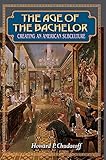The Age of the Bachelor : Creating an American Subculture / Howard P. Chudacoff.
Material type: TextPublisher: Princeton, NJ : Princeton University Press, [2020]Copyright date: ©1999Description: 1 online resource (352 p.) : 24 halftones, 9 tablesContent type:
TextPublisher: Princeton, NJ : Princeton University Press, [2020]Copyright date: ©1999Description: 1 online resource (352 p.) : 24 halftones, 9 tablesContent type: - 9780691222011
- Bachelors -- United States
- HISTORY / United States / 20th Century
- African Americans
- Chicago, Illinois
- Ehrenreich, Barbara
- Forum magazine
- Germans
- Goffman, Erving
- Groves, Ernest
- Holland, Hilda
- Hustler
- Illinois
- Irish
- Italians
- Jessel, George
- Jews
- Kansas City, Missouri
- Killrain, Jake
- Kingsdale, Jon
- Lithuanians
- Maryland
- Massachusetts
- New Haven, Connecticut
- New York World
- Oliver, Charles
- Progressive era
- amusement parks
- apprenticeship
- baby boom
- ballparks
- barbershops
- blue-plate special
- boarders
- breach of promise suits
- cabarets
- clubs and associations
- competition
- dance halls
- demographic theory
- deviance
- dime museums
- eating arrangements
- family law
- family
- fire companies
- frontier
- gymnasiums
- laundries
- marriage age
- middle class
- music
- occupation
- physical culture
- physicians
- pool halls
- residential patterns
- saloons and taverns
- seduction suits
- sporting culture
- 305.389652 23
- HQ800.3
- HQ800.3 .C58 2000eb
- online - DeGruyter
| Item type | Current library | Call number | URL | Status | Notes | Barcode | |
|---|---|---|---|---|---|---|---|
 eBook
eBook
|
Biblioteca "Angelicum" Pont. Univ. S.Tommaso d'Aquino Nuvola online | online - DeGruyter (Browse shelf(Opens below)) | Online access | Not for loan (Accesso limitato) | Accesso per gli utenti autorizzati / Access for authorized users | (dgr)9780691222011 |
Browsing Biblioteca "Angelicum" Pont. Univ. S.Tommaso d'Aquino shelves, Shelving location: Nuvola online Close shelf browser (Hides shelf browser)

|

|

|

|

|

|

|
||
| online - DeGruyter Germany Divided : From the Wall to Reunification / | online - DeGruyter Colonizing Hawai'i : The Cultural Power of Law / | online - DeGruyter The Politics of Social Policy in the United States / | online - DeGruyter The Age of the Bachelor : Creating an American Subculture / | online - DeGruyter Groundless Belief : An Essay on the Possibility of Epistemology - Second Edition / | online - DeGruyter Historia Patria : Politics, History, and National Identity in Spain, 1875-1975 / | online - DeGruyter Passions and Deceptions : The Early Films of Ernst Lubitsch / |
Frontmatter -- Contents -- Acknowledgments -- INTRODUCTION The Age of the Bachelor -- CHAPTER ONE Bachelorhood in Early American History -- CHAPTER TWO Why So Many Bachelors? -- CHAPTER THREE The Domestic Lives of Bachelors -- CHAPTER FOUR Institutional Life -- CHAPTER FIVE Associations: Formal and Interpersonal -- CHAPTER SIX The Popular Culture of Bachelorhood -- CHAPTER SEVEN Bachelor Subculture and Male Culture -- CHAPTER EIGHT The Decline and Resurgence of Bachelorhood, 1930-1995 -- Appendix -- Notes -- Index
restricted access online access with authorization star
http://purl.org/coar/access_right/c_16ec
In this engaging new book, Howard Chudacoff describes a special and fascinating world: the urban bachelor life that took shape in the late nineteenth century, when a significant population of single men migrated to American cities. Rejecting the restraints and dependence of the nineteenth-century family, bachelors found sustenance and camaraderie in the boarding houses, saloons, pool halls, cafes, clubs, and other institutions that arose in response to their increasing numbers. Richly illustrated, anecdotal, and including a unique analysis of The National Police Gazette (the most outrageous and popular men's publication of the late nineteenth and the early twentieth century), this book is the first to describe a complex subculture that continues to affect the larger meanings of manhood and manliness in American society. The figure of the bachelor--with its emphasis on pleasure, self-indulgence, and public entertainment--was easily converted by the burgeoning consumer culture at the turn of the century into an ambiguously appealing image of masculinity. Finding an easy reception in an atmosphere of insecurity about manhood, that image has outdistanced the circumstances in which it began to flourish and far outlasted the bachelor culture that produced it. Thus, the idea of the bachelor has retained its somewhat negative but alluring connotations throughout the rest of the twentieth century. Chudacoff's concluding chapter discusses the contemporary "singles scene" now developing as the number of single people in urban centers is again increasing. By seeing bachelorhood as a stage in life for many and a permanent status for some, Chudacoff recalls a lifestyle that had a profound impact on society, evoking fear, disdain, repugnance, and at the same time a sense of romance, excitement, and freedom. The book contributes to gender history, family history, urban history, and the study of consumer culture and will appeal to anyone curious about American history and anxious to acquire a new view of a sometimes forgotten but still influential aspect of our national past.
Mode of access: Internet via World Wide Web.
In English.
Description based on online resource; title from PDF title page (publisher's Web site, viewed 07. Nov 2022)


